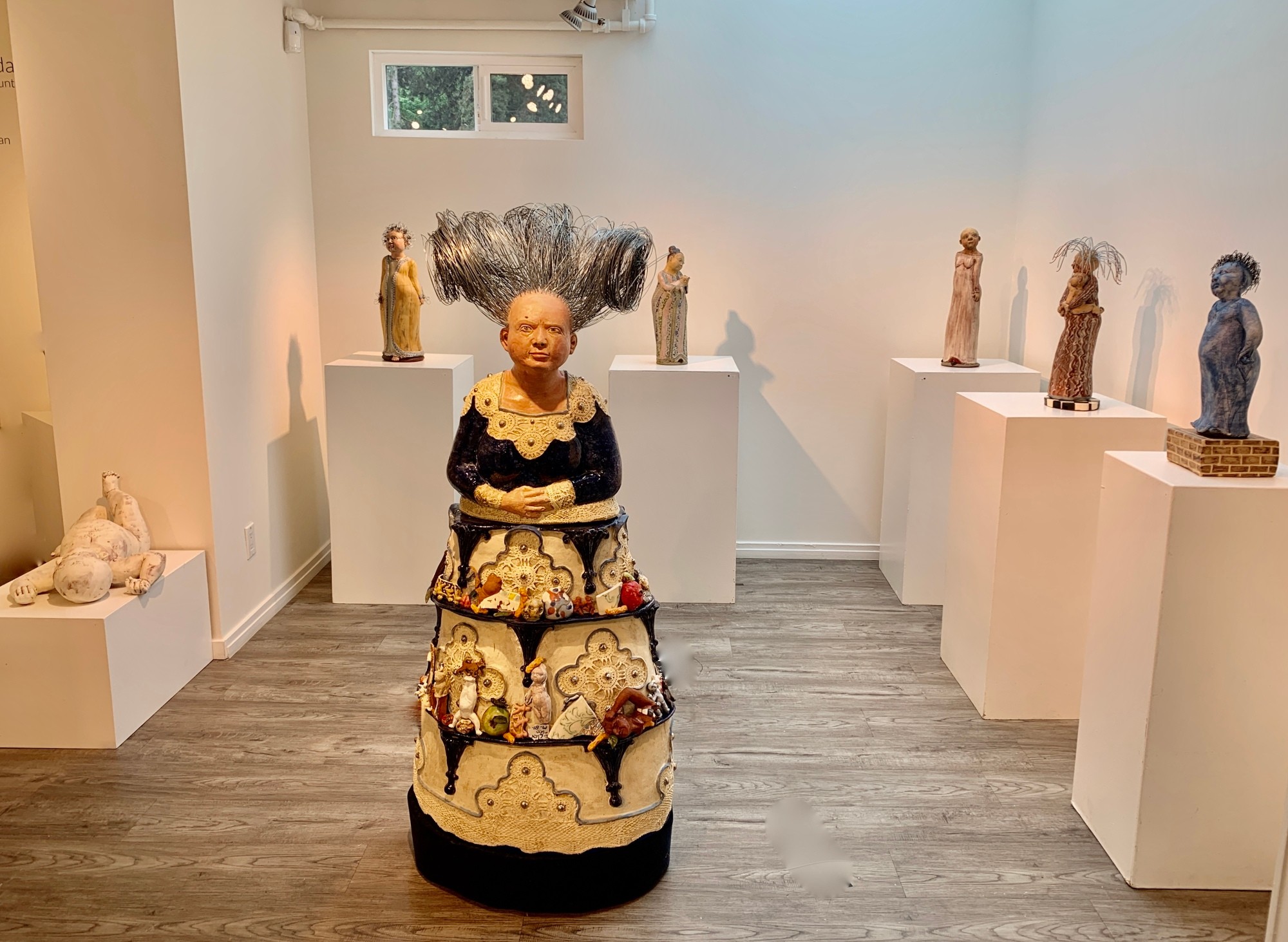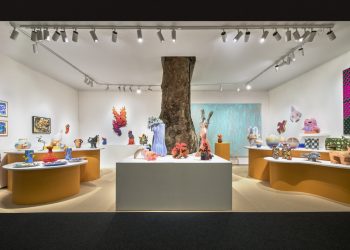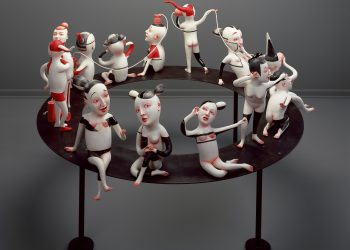Part I. Review of Debra Sloan: Les Grandes Dames
Part II. Interview with Debra Sloan
Interview with Debra Sloan
The following edited interview of Debra Sloan was conducted by Amy Gogarty on June 25, 2024, on the occasion of her exhibition Les Grands Dames at the Craft Council of BC in Vancouver, Canada.
What encouraged you to look at the Tang Dynasty tomb figures of women and use them as inspiration in your own work?
My first real contact [with these figures] was at the Chicago Art Museum in 2015. They had a horse and rider, an equestrian figure. I was really interested in the equestrian figure because of my interest in the Leach roof tiles. My piece in the show is very similar–a woman leaning forward on her horse. I was gobsmacked at how refined the Tang figure was, how emotive. Something was going on between the horse and rider, how they were communicating. That was the first thing that attracted me, other than the simple beauty of the horse. The other thing was the dynamic, the fact that it was a woman riding, looking independent and competent. I began to look at the Tang, the status of women, and that triggered the interest. That, and the fact that they are so virtuosic.
Why women?
Dealing with female issues and watching the fate of women, no matter what cause we follow, 50% are women. Whether we look at ecology, climate, spousal abuse, politics, women’s rights–we keep forgetting that. With COVID-19, there were those terrible stats of spousal abuse, plus all that is going on in the US with abortion, etc.
This is connected with your work on sexual assault?
I have been working with that topic because the exhibition we [the Craft Council of BC] will be putting on, which is part of the IMPACTS: Collaborations to Address Sexual Violence Project. The exhibition is called Walking Alongside Trauma. So this has been on my mind. The exhibition is about people who assist those who have experienced sexual violence—paramedics, doctors, nurses, priests—people who listen to and absorb all of these stories. We are looking at secondary trauma—what they take home to their families and their communities. Any kind of violence, but particularly sexual violence, has a ripple effect.
For my own research, I have been looking at times in history when women have had some autonomy. For example, Cleopatra. I read an excellent biography of Cleopatra by Stacey Shiff [Cleopatra: A Life, Little, Brown & Co, 2010]. She lived at a time when women had a degree of autonomy in Egypt. They could request their dowries back and leave their husbands; they could own property. You can count on one hand times when women did have freedom, even today, in so many places in the world. We live so much in our own bubble and don’t see the whole picture.
How safe are we as women really? The minute there is a level of disruption, or women can’t get hold of birth control, or men take over, we’re in trouble. It makes me very nervous! It all comes down to how women are perceived—either as Madonnas or whores—nothing in-between. Women are either sexualized or a mother—or a hag. It’s getting better, but we still hear unfair criticism of women based on their appearance—they are slammed for being chubby, or for changing their hair. Men don’t get slammed. Who’s slamming Trump in public for being obese or for his ridiculous hair? It’s getting better in the Western World, but there is still a long way to go. So, I just thought I would focus on women instead of babies.
I said before that you have worked with babies, which I know you use not as cute little things but to comment on society, gender, and other things. This show provides a wonderful example.
I have worked with babies and appreciate you mentioning the Mexican ones. When I was teaching, I used to end all of my classes with slide shows. I photographed one of the Olmec babies, and I remember thinking “oh, oh,” but everything is right there. This was maybe in the mid-nineties. But I didn’t start making the babies until around 2010. I had a few years when I was very busy looking after my parents, my kids were graduating, and I was very tied up in family stuff. But the Olmec babies were one of the instigators of my babies. Also, the Colima dogs. Someone in the 90s gave me a book on the Colima dogs—I had made a dog, but these also influenced me.
You have mentioned your interest in volumetric qualities in your work. How do you approach this?
For me, it is a guilty pleasure. I start with a fairly simple tube, either thrown or hand-built, and then dive inside. I mark where the different parts of the body are on the outside, and then I go in—either with my hands or with a tool, if it is quite narrow, and I push it out. I can push it back in and go back and forth until I am happy. It’s a sort of guilty pleasure to watch clay expand. If I only work from the outside, the form is dead.
It’s like what Paul Mathieu talks about, that the interior space is a pregnant space; it has meaning in ceramic sculpture.
Yes, and we talk about breath. There are so many ways that clay is similar to us, all the words we use to discuss clay. If I don’t work from the inside, it just seems flat. And then I can take advantage of ideas like pregnancy, or post-pregnancy, going wider. It could be an unconscious response to women being dissed for being fat. But it “inhales.” Clay has such a life-like quality when it is soft leather-hard—the best time. It’s like youth—such a short time—it comes, and then it’s gone! I try to prolong my working time as much as possible because I am constantly interrupted—by work, kids, or running a house. That’s why residencies are so important. I’ve become really adept at maintaining my working hours. We are lucky to live where it is damp, so you can do this.
What is your relationship to surface treatments and how the surface relates to the form?
Surface treatment is like great architecture in old Europe—I haven’t spent enough time in Asia to judge–but looking at the patina on old buildings, these layers of history and time. It’s something you have to look for very hard here in Vancouver, and I viscerally miss it. I miss the surface decoration on buildings—tiles, carvings, pediments. There are a few buildings, but they are rare. With ceramics, the surface is a way to create a patina, a sense of history and time, a way of prolonging or adding to the story, or adding in such a way that the person looking at it can think of a story, can relate to it in some way. It adds a layer of meaning to the piece, another layer of commentary. When working on the surface, you operate around the form—either with or against the form- to accentuate the gesture, as with Plain Jane With Petticoat. In the case of Edgy Hair, I worked over the surface with white slip, leaving brush marks. This definitely relates to the form. It’s like a gauzy-veil sort of garment. Then the cobalt wash emphasizes the slip marks—she is drenched in blue. I am thinking blue in terms of mood, so colour comes into it. With Dress for Pup‘s elaborate surface, it was partly having fun playing with transfers. I wanted to give her a sumptuous dress. I was thinking of those court ladies. There is a spectacular Tang court lady holding a small dog. She doesn’t have an elaborate dress, but the form, the way the dog is tucked into her body are fantastic. She is clearly a lady of leisure—there is a story here. I didn’t do any grids, which I often do, as a way to back off from how figurative it is, to put a level of abstraction into the work, to move away from the literalness of the figure. The grid refers to skyscrapers, the inhumanity and brutalness of many skyscrapers.
Can you describe the process you went through with Drew Shaffer to create the collaborative work The Big Skirt – A Museum? Can you see yourself doing more collaborations in the future? What do you think that adds to this exhibition?
Drew and I had been discussing collaborating for some time. He was a dear friend of my sister, but once we began to work together, we realized we had a lot of friends in common. I wanted to do something big and wanted someone big and strong to help! He is a multi-media artist, so he comes to the project from a completely different direction. I knew exactly what I wanted to do—a big woman with a big skirt. We worked together over a weekend and only got as far up as the waist. I made the upper body and face, and then he came back. He had done experiments with dipping lace in slip and colour tests. The lace really worked well for him. He is very knowledgeable about art and art history, so he had models he knew about. We looked at Viola Frey to see how we could cut the figure to make it so that it could be transported. He wanted to make the shelves on the skirt and add pieces–fragments, remnants–of my work. He built the base as a trolley for the work to sit on. At this point, I went away on a residency and turned it over to Drew to complete.
Drew worked with my sister. He had made a corbel. I made a mold of it, press-molded the corbels, and made the face. He then applied the lace and added the cartouches and the corbels. I then once fired it. I did not worry about it. I knew it would be interesting and was willing to give up control. I felt the exhibition needed one large piece to contrast with all the similarly-sized smaller figures. It’s exciting to do something completely risky and see what happens. I am willing to accept the fact that it might not work—even if it did not work, it would go into the show. The hair was a nightmare—putting all those soft wire pieces into the head took days. The wire is soft but oily, so it leaves your hands black. And it’s heavy. I wanted it to be silvery, so I added a silvery wire. It was hard to curl it into the shape I wanted—the different wires all had different levels of pliability. And then I added in fishing line, which was crazy. I finally delivered the work a few hours before the opening. I was all scratched and bleeding from the wire. It adds a level of excitement to do something that is off the cuff. I really want to give Drew credit—for how he managed things and the way he picked up working with clay. He would just ask—can I do this or do that? I just checked that things worked technically, but otherwise, it was him.
Can you say something about the scale of the work? How did you decide on the scale?
Scale is something I think I should pay more attention to. I was a potter for quite a few years. You automatically go to that “pot size.” The pieces are larger than figurines, so they are a funny scale. I work so instinctively—I don’t say, “Debra, you should make things this size.” Maybe I should do that more. I do that with the babies. I wanted the baby in the show to be really big, intentionally to inflate the idea of the baby, its presence. The scale has so much to do with an instinctive return to the vase.
You do quite a lot of advocacy work for ceramics in your community. What do you think about the state of ceramics in BC, Canada, or the wider world at this time?
I think ceramics is going in all sorts of directions. I am optimistic. I think the applied arts are beginning to blossom. It’s like music with a melody, something you can attach yourself to. The material arts bring something to people, a certain familiarity, a presence, a touch, historical resonance. At this moment in time—after a long time of being disregarded—the material arts are coming into their own. Curators are still not looking at people like me who are working with materials as a material artist. They are looking at artists who come in and make something using a material, bringing it into a new context, perhaps, a new way of looking at it. It’s very interesting, and I appreciate it, but I still think most curators are uncomfortable with people who work in a more traditional way. I am still working with ceramics in a traditional way, with respect for craft, and I’m not trying to make it other than it is. I’m still trying to use clay as a platform and drag my traditional art into making it relevant to people today. I am still an insider. When I brought Drew in, he was an outsider. I thought it was interesting to bring in someone who approached it as a multi-media artist, not as a clay artist. I hope to do more collaborations—I want to do a giant, 18-to-20-foot baby on the sand looking out to the sea, but out of brick. I would need a collaborator for that!
In BC, no museums are devoted to the material arts—we are bereft. In the east [of Canada], there are several museums—the Gardiner, the Clay and Glass Gallery, and the Textile Museum–which specialize in material arts. But here, it is completely up to small groups like the Craft Council, which are underfunded, to educate the public because the big institutions are just not doing it. The roots of my advocacy come from the absence of institutional interest in ceramics in BC and, to a lesser extent, Canada. My thinking for the last thirty years has been that we have to create a base of information—that’s why I began to collect the marks [the BCCMR—BC Ceramics Marks Registry], the archives, the biographies of artists, the newsletters. I took archives around to different libraries to preserve. The information has to be there—someday, someone will do the research, and they will find this trove of information. We have to create a provenance, preserve the history, and attract enough attention to get our museum out here in BC.
Amy Gogarty is an independent researcher, writer, and artist living on the unceded shared traditional territories of the Coast Salish Peoples, including the territories of the xʷməθkwəy̓əm (Musqueam), Skwxwú7mesh (Squamish), and Səl̓ílwətaʔ/Selilwitulh (Tsleil-Waututh) Nations. She studied at ACA (now AUArts) and the University of Calgary, receiving her MFA in Painting in 1989. She taught histories and theories of visual arts at ACAD in Calgary for sixteen years prior to relocating to Vancouver in 2006. She has exhibited her paintings and ceramics locally and nationally and is the author of over 120 critical essays, reviews, or presentations relating to visual art and craft practice. In 2021, she was named an Honorary Member of NCECA and short-listed for the Canadian Crafts Federation Robert Jekyll Award for Leadership in Craft. She sits on the Board of the North-West Ceramics Foundation and is a passionate supporter of ceramics in British Columbia.* (*Source: Craft Council of British Columbia’s website)
Debra Sloan: Les Grandes Dames is on view at the Craft Council of British Columbia, Vancouver, between June 6 and July 25, 2024.
Visit Debra Sloan’s website.
Ceramics Now is a reader-supported publication, and memberships enable us to produce high-quality content like this article. Become a member today and help us feature a wider range of voices, perspectives, and expertise in the ceramics community.















